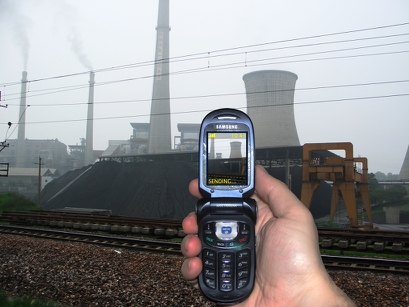The deputy editor of the Economist, Robert Cottrell, thinks he knows what I'm up to. Well, me and the myriad other folks working to analyze what the future could hold, in order to make better choices. In "The future of futurology," Cottrell argues that the only way to have any credibility as a futurist to think small, think short-term, and shut up.
So there you are on the moon, reading The World in 2008 on disposable digital paper and waiting for the videophone to ring. But no rush, because you're going to live for ever-and if you don't, there's a backed-up copy of your brain for downloading to your clone.
Yes? No? Well, that's how the 21st century looked to some futurologists 40 or 50 years ago, and they're having a hard time living it down now.
There's a long-standing canard in most conversations about "thinking about the future in a formal way" (a term to avoid the legacies of "futurism," "futurology," and "foresight" -- call it TATFIAFW, or TATF for short). It is rooted in the concept that TATF is a behavior, not a process, and that people who think about the future today do so in exactly the same way as those who did so 50 or 100 or 200 years ago. It's like singing -- some people do it better than others, and there's some training one can do, but people today as a whole aren't any better or worse at singing than people of centuries past. Criticisms of TATF based on past failures or lunacies (pun intended), from this perspective, are equally valid when carried to modern TATF.
If we think of TATF as a process, a skill, or a practice (avoiding the loaded term "social science"), however, it stands to reason that techniques can improve over time. That it's possible to learn from past mistakes. That the changes in our various academic understandings of the world -- greater cross-disciplinarity, greater awareness of systemic processes, greater reliance on peer review -- have influenced the practice of TATF, too. Ultimately, that we can say that what we do when we think about the future today is measurably more useful and insightful than what was done 40 or 50 years ago.
Not for Cottrell. He'd rather that we not worry about what's down the road, and focus only on the immediate future.
You can still get away (as we do) with predicting trends in the world next year, but push the timeline out much further, and you might as well wear a t-shirt saying "crackpot".
I'll keep that in mind next time the Economist prints a story about energy use projections (nearly always going through 2020 or 2030), population projections (2050), or any economic analysis (particularly of climate change) that declares with great certainty the impending financial doom of trying to reduce carbon footprints.
The problem may not be the reach, but the scope. There are fields in which it's acceptable to talk about timelines far greater than 1-2 years. We regularly see mainstream discussions of very long-term trends in energy and finance (e.g., Social Security) that talk about points in the future still decades away. What doesn't seem acceptable -- at least to Cottrell -- is any effort to combine these various narrow projections to look for contradictions or reinforcing systems.
But that's exactly what a futurist -- sorry, TATFist -- does.
It's clear, however, that Cottrell (who actually goes on the speaker circuit as a futurist) has an extremely dated view of what TATF really is all about.
Small wonder that futurology as we knew it 30 or 40 years ago-the heyday of Alvin Toffler's "Future Shock", the most popular work of prophecy since Nostradamus-is all but dead.
Because, as we know, no other form of study or intellectual analysis has changed form or approach in the last 30 or 40 years. Oh, wait.
Economic analysis as we knew it 30 or 40 years ago is all but dead.
Political analysis as we knew it 30 or 40 years ago is all but dead.
Environmental study as we knew it 30 or 40 years ago is all but dead.
...and so forth. In those cases, many of the books from 30-40 years ago are still used in understanding the history of the disciplines, but the same can be said of books like Tofflers in the handful of academic futures studies departments.
The larger point is that professional TATF long ago dropped any pretense of offering predictions or prophecies. Single-point predictions are rarely even broadly correct; of greater value are sets of possibilities, offering insights into what kinds of forces are at work shaping how the present becomes the future. For some professionals, this means scenarios; for others, this means mapping. Regardless of the exact methodology, the purpose is to uncover unexpected potential outcomes, allowing strategists and decision-makers to come to more sophisticated and productive conclusions.
One of Cottrell's pieces of evidence is that you don't see TATFists in the media these days.
There are plenty of them about, but they have stopped being famous. You have probably never heard of them unless you are in their world, or in the business of booking speakers for corporate dinners and retreats.
Or you watch the news (where Paul Saffo shows up all the time), or listen to NPR (where Stewart Brand shows up all the time), or work for the US government (where Peter Schwartz shows up all the time), etc.. But I'll concede Cottrell's larger point: there are no celebrity futurists, and there used to be (at least Alvin Toffler). But back in the 1960s, there were celebrity academics of all kinds. That era's efforts to market celebrity would seem primitive today, and social/cultural elites had more say over what names and faces appeared in the narrow forms of popular media. That the celebrity culture has changed, so that more people are conversant with Paris Hilton than Bob Johansen, is not in and of itself a useful measure.
But Cottrell compounds his errors by claiming that, in actuality, there wasn't much interesting going on in the 1960s, so the West listened to TATFists out of boredom.
We can see now that the golden age of blockbuster futurology in the 1960s and 1970s was caused, not by the onset of profound technological and social change (as its champions claimed), but by the absence of it.
Remind me -- when did the civil rights movement, the women's rights movement, the last great uprising of the IRA, the opening of China, the acceleration of the end of imperialism in Africa, all of that -- when did that happen?
Oh, right, the 1960s and early 1970s. Good thing profound social change was absent, or else things would have been *really* chaotic.
Futurologists extrapolated the most obvious possibilities, with computers and nuclear weapons as their wild cards. The big difference today is that we assume our determining
forces to be ones that 99% of us do not understand at all: genetic engineering, nanotechnology, climate change, clashing cultures and seemingly limitless computing power.
Implying that, back in the day, a greater percentage of people understood computers and nuclear weapons. Look at the popular media of the era, and it's damn clear that they didn't know how computers worked. Nuclear weapons are another story, because the ultimate impact of nukes is hard to mistake -- that said, I'd be surprised if Cottrell (or the Cottrell of 1970) could adequately explain how a hydrogen bomb works, what a permissive action link is, or how mutual assured destruction differs from massive retaliation (the two big deterrence models of the era).
When the popular sense of direction is baffled, there is no conventional wisdom for
futurologists to appropriate or contradict.
And in this one sentence, Cottrell demonstrates his profound misunderstanding of the purpose of thinking about the future. If you recognize that TATF is more than just trying to spot marketing trends, this moment -- "when the popular sense of direction is baffled" -- is precisely when thinking about future possibilities is the most valuable.
But Cottrell will have none of that. He would much rather we think only about marketing niches.
But the best advice for aspirant futurists these days is: think small. The best
what-lies-ahead book of 1982 was "Megatrends", by John Naisbitt, which prophesied the future of humanity. A quarter-century later, its counterpart for 2007 was "Microtrends", by Mark Penn, a public-relations man who doubles as chief strategy adviser to Hillary Clinton's 2008 presidential campaign. [Oh, great -- JC] "Microtrends" looks at the prospects for niche social groups such as left-handers and vegan children. The logical next step would be a book called "Nanotrends", save that the title already belongs to a journal of nano-engineering.
And that is the only reference to an emerging technology with the potential to disrupt existing economic, social and even military models. But there's no sense that it might be a wee bit useful to think through the implications of emerging issues like that; instead, we're told to follow the path of Faith Popcorn, consumer marketing guru of the early 1990s.
The next rule is: think short-term.
And by short-term, he means consumer behavior. Snapshots of the next five minutes, not maps of tomorrow.
A third piece of advice: say you don't know. Uncertainty looks smarter than ever before.
This is one rule that I agree with wholeheartedly. Could Cottrell be on a path of now making sense?
A fourth piece of advice for the budding futurist: get embedded in a particular industry, preferably something to do with computing or national security or global warming. All are fast-growing industries fascinated by uncertainty and with little use for generalists.
No, he's not. Setting aside issues of being biased by being embedded (something journalists learned about recently in Iraq), this is simply more misunderstanding of what we're trying to do. Generalism is the heart of TATF, because that's what makes the practice valuable: being able to see the connections that would otherwise be hard to spot for people embedded in a particular industry.
Cottrell cites climate scientists being unwilling to make projections of possible impacts, and asks how TATFists can think they'd do better. Well, for one, the TATFist is likely to have a better chance of seeing new models for dealing with certain and possible problems. And more likely to see unexpected combinations with non-climate issues. And to provide a context for the climate scientists to imagine how the possible effects might emerge.
A fifth piece of advice: talk less, listen more. Thanks to the internet, every intelligent person can amass the sort of information that used to need travel, networking, research assistants, access to power.
And here's his other rule that I agree with. But then he goes and ruins it.
The most heeded futurists these days are not individuals, but prediction markets, where the informed guesswork of many is consolidated into hard probability.
Because we know that these hard probabilities are in no way providing a false sense of certainty and bias confirmation, and are always accurate.
Honestly, what this all says to me is that this guy really doesn't know much about what he's talking about, and assumes that because he hasn't been following the field, the field hasn't changed.

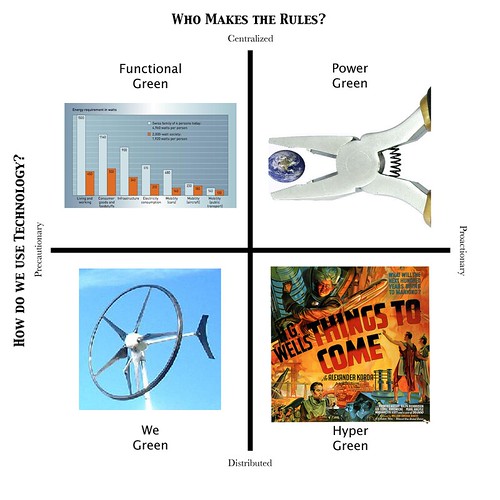
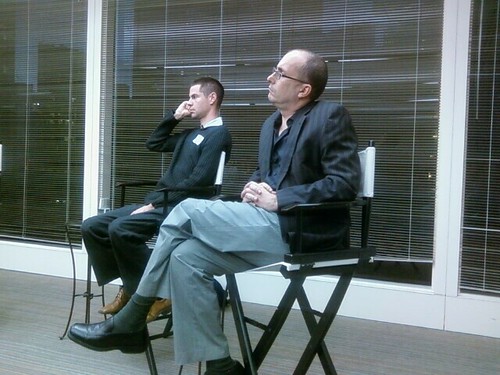
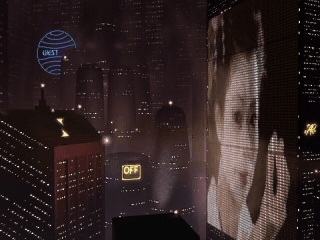
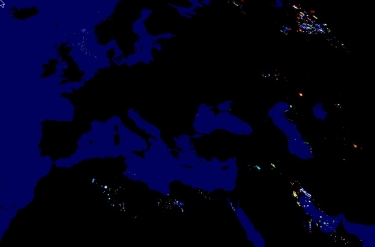 One of my favorite early pieces for WorldChanging was the essay
One of my favorite early pieces for WorldChanging was the essay 